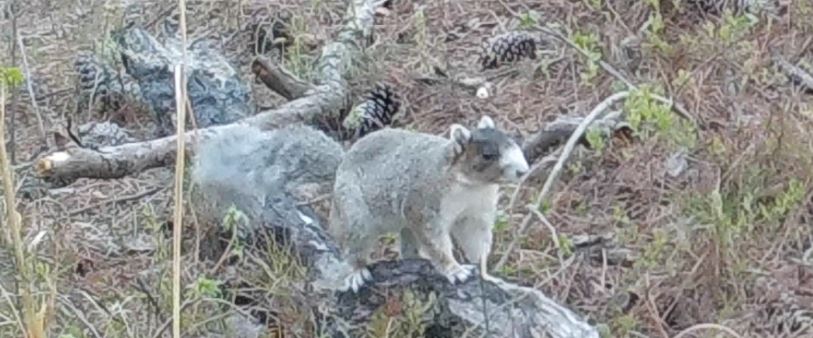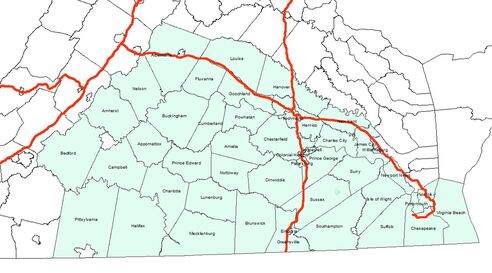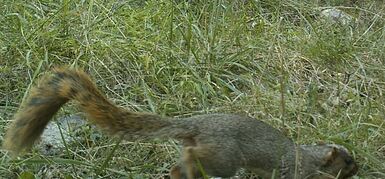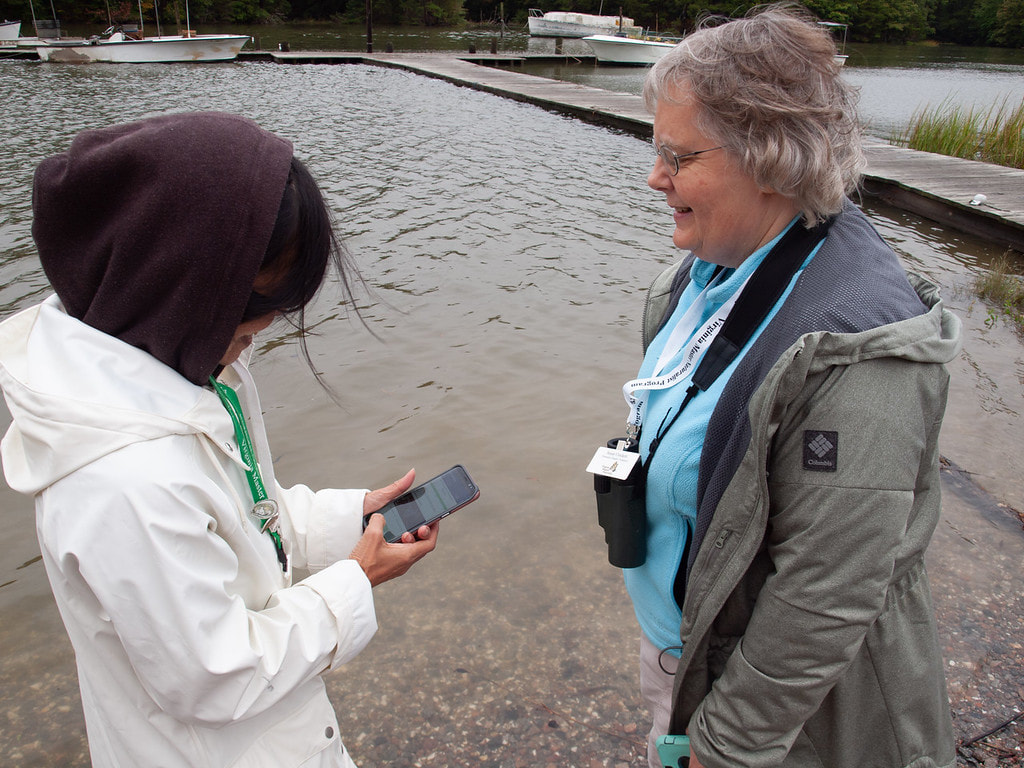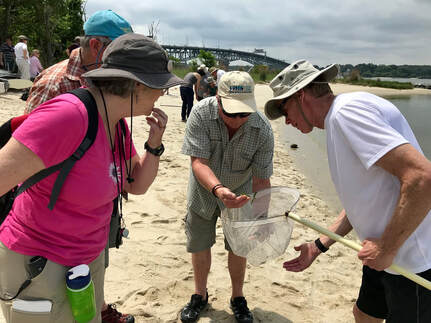New Natural History Research Articles by Virginia Master Naturalists
Banisteria, the journal of the Virginia Natural History Society is now completely electronic and Open Access. Articles are now posted on the VNHS website as soon as they are reviewed and formatted. At the end of each year, they are compiled into a single PDF, also posted on the website.
The VNHS welcomes contributions of natural history research articles by Virginia Master Naturalist volunteers. In fact, two of the articles in the current edition (Number 54, 2020) were co-authored by VMN volunteers!
John Bunch (VMN-Historic Southside Chapter) contributed a report of a fascinating study he has made of the Eastern Hercules Beetle, co-authored with entomologist Art Evans. Two interesting observations (of many): the male beetles make an odor that smells like blueberries and the males also cause distinctive scars on ash trees that remain visible for years.
Adrienne Frank (VMN-Historic Rivers Chapter) is the lead author of an article on the annotated butterfly checklist for the greater Williamsburg area created by Virginia Master Naturalist and Coastal Virginia Wildlife Observatory volunteers. Co-authors include Ken Lorenzen and Brian Taber.
Well done, John and Adrienne! We encourage everyone to read their articles and to think about how you might share your own VMN natural history studies in Banisteria.
A Virtual Vernal Pools Experience with the New River Valley Chapter
Contributed by Dianna Bridges
Judy McCord, a Certified Virginia Master Naturalist volunteer in the New River Valley Chapter, worked with Claytor Lake State Park to make a video on vernal pools that was featured earlier this year on the Virginia State Parks Facebook page. Along with monitoring the vernal pools at the park, Judy also collects data for FrogWatch there and assists with education programs.
Check out the video to learn about vernal pools and aquatic organisms and to see a VMN in action!
 Hidden Oaks Nature Center. Photo contributed by Marilyn Schroeder, VMN-Fairfax Chapter.
Hidden Oaks Nature Center. Photo contributed by Marilyn Schroeder, VMN-Fairfax Chapter.
Fairfax Master Naturalists Recognized for Service in County Parks and Nature Centers
Contributed by Marilyn Schroeder and Janet Quinn VMN-Fairfax Chapter
Hidden Oaks Nature Center recognized four Fairfax Master Naturalists with the 2019 Presidential Service Award for volunteer service that year. Bob Dinse received the silver award for volunteers who contributed 250-499 hours. Val Bertha, Hank Dahlstrom, and Marilyn Schroeder received the bronze award for volunteers who contributed 100-249 hours.
Scott Schroth was recognized in August 2020 as the Volunteer of the Month for Fairfax County’s Riverbend Park and Scott’s Run Nature Preserve.
He participated in several invasive removal and habitat restoration projects and led watershed cleanup activities over the summer. Scott particularly enjoys citizen science opportunities such as wildflower surveys, native grass seed collection, and the Adopt-a-Spot program. Read more about Scott on the
Fairfax Master Naturalist Chapter website.
Cathy Ledec will be honored in November with the 2020 Sally Ormsby Environmental Stewardship Award for 17 years of volunteer service at Huntley Meadows Park and for the Fairfax County Park Authority. This award recognizes individuals and organizations whose actions embody the spirit and values of stewardship and result in tangible environmental benefits. In the award nomination, Ledec was cited for making an “enormous difference” at Huntley Meadows Park, Mt. Eagle Park and other FCPA properties. Read more about Cathy’s work on the
Fairfax County website.
Historic Rivers Chapter Laurels for Cheryl Jacobson, Judy Jones, Shirley Devan, and Dave Youker
Contributed by Meagan Thomas, Historic Rivers Chapter co-advisor and VDWR Watchable Wildlife Biologist
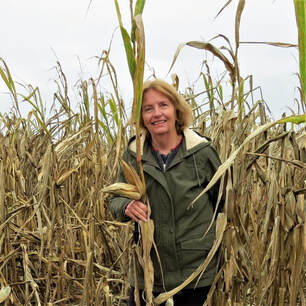 Cheryl Jacobson, a Certified Virginia Master Naturalist volunteer in the Historic Rivers Chapter, has recorded more than 6,000 hours of service.
Cheryl Jacobson, a Certified Virginia Master Naturalist volunteer in the Historic Rivers Chapter, has recorded more than 6,000 hours of service.
Cheryl Jacobson Reaches the 6,000 Hour Milestone
It is with great pride that the Historic Rivers Chapter adds Cheryl Jacobson to our list of members who have achieved the 6000-hour milestone. Cheryl, who became a Virginia Master Naturalist in 2011, has recorded over 6,000 hours of energy and enthusiasm, leading many projects as well as participating in a huge variety of activities. For example, she has recorded 4500 hours of citizen
science, with hours ranging from directing our local Osprey Watch project, to monitoring butterflies, to assisting with the leadership of the spring and Christmas Audubon bird surveys, to serving as one of our coordinators for our Chapter’s bluebird trails, and most recently, being the springboard for our new and wonderful Purple Martin Project. She has also served on our HRC board, led educational activities and nature clubs in schools, parks, and the New Kent Forestry Center, and provided leadership in our stewardship activities, ranging from helping to create a rain garden, to picking up litter and ‘Keeping JCC Beautiful’, to collecting acorns for the Forestry Center and making oyster reef balls for VIMS.
We are so proud of Cheryl and the energies and enthusiasm she has brought to the Chapter and to our Tidewater families. It is characteristic of our Chapter that her enthusiasm has been nurtured and has flourished without flagging for nearly 10 years but it is truly a tribute to Cheryl that she has not only achieved this personal goal but definitely made a difference in the environment and in our community.
Kudos to our amazing Master Naturalist – Cheryl Jacobson!!!
Cheryl is part of our VMN Golden Circle.
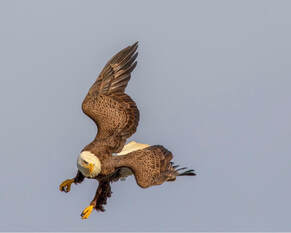 Bald eagle photo by Judy Jones.
Bald eagle photo by Judy Jones.
Recognition for an Amazing Photo
Historic Rivers chapter member Judy Jones had one of her photographs selected for display in the Virginia Wildlife Magazine’s 2020 Photo Showcase (July/August edition). The photo was taken on January 6th, 2020 and depicts a mature bald eagle diving for fish on the James River. Judy managed to snap the magnificent photo just as the eagle was doing a midair about face after glimpsing a fish in the water below.
The James Eike Service Award recognizes two Virginia Master Naturalists from the Historic Rivers Chapter for outstanding service to the Virginia Society of Ornithology.
Shirley Devan was nominated by Patti Reum, with letters of support from Dan Bieker and Lenny Bankester. Shirley is heartily recognized for her long-term commitment to the VSO board, serving in the challenging role of Membership Chair. Her use of Constant Contact has vastly improved communications with our members. Shirley has attended many of the VSO field trips and organized a team for the annual Kiptopeke Challenge.
Dave Youker was nominated by Jane Frigo, with letters of support from Pete Peterman and Thomas Charlock. Quoting Jane, “his contributions to the Virginia Society of Ornithology and other statewide projects to enhance, educate and preserve our avian populations span more than a decade. He does not seek out attention for his efforts but quietly continues to work toward providing a future for our avian populations and sharing that knowledge.”
Dave’s noteworthy accomplishments include, among many others, his service to VARCOM and the Hampton Roads Bird Club, his work at the Western Shore Marshes IBA, avian surveys at Craney Island, Grandview and Hampton Roads Bridge/Tunnel, managing the MOTUS operation at Craney Island and participating in a VSO sponsored avian population study in the Dominican Republic. Dave also serves as regional coordinator of the 2nd Breeding Bird Atlas.
These awards were to be presented at the VSO Annual Meeting, which was canceled this spring because of the pandemic. Awardees will be recognized at the next publicly held event.
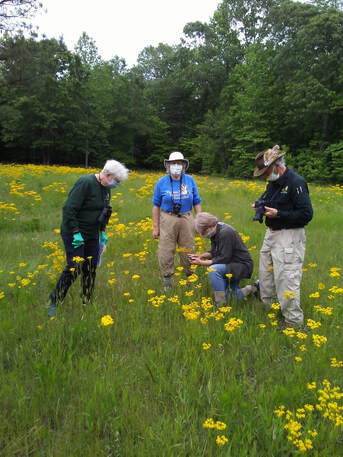 Middle Peninsula Master Naturalists help conduct the Northumberland-Lancaster butterfly count. Left to right: Debbie Rollins, Susan Crockett, Jan Tyndall, and Bill Blair (count sector leader.) Photo by Edie Bradbury.
Middle Peninsula Master Naturalists help conduct the Northumberland-Lancaster butterfly count. Left to right: Debbie Rollins, Susan Crockett, Jan Tyndall, and Bill Blair (count sector leader.) Photo by Edie Bradbury.
2020 MPMN Contributions to Butterfly Counts Contributed by Susan Crockett, VMN-Middle Peninsula Chapter
Twelve members of the Middle Peninsula Master Naturalist Chapter volunteered for eight North American Butterfly Association (NABA) butterfly counts this spring, summer, and fall. Between May and September they contributed 456 hours of counting butterflies in five different areas: Northumberland and Lancaster Counties, Essex and Northern Neck Counties, Virginia Beach (including the Hampton Roads Agricultural Research and Extension Center, Back Bay National Wildlife Refuge), Chippokes Plantation State Park, Williamsburg, York and Gloucester Counties). Because of their efforts counting in the Gloucester sector of the Williamsburg Area Count was included for the first time in 14 years. The members were: Bill Blair, Edie Bradbury, Michelle Brown, Chris Conley, Susan Crockett, Carol Kauffman, Jack Kauffman, Jeannie Miller, Debbie Rollins, Sherry Rollins, Jan Towne, and Jan Tyndall. Bill Blair, Susan Crockett, and Jan Towne also served as sector leaders in several of the counts.
It Takes a Village
Contributed by Charlene Uhl, Kathleen Aucoin, Bonnie Beers, Carolyn Smith, and Barry Buschow, VMN-Old Rag Chapter
When the Old Rag Master Naturalist chapter’s 2020 Basic Training class (Class X) was postponed due to COVID-19, the Basic Training Committee (BTC) kicked into high gear to keep the class engaged and involved through a variety of efforts. Monthly conference calls were held with trainees and many of their mentors, discussing topics such as journaling, naturalist books, projects that could be done alone or within social distancing guidelines, and rich conversations among trainees and mentors ; book bundles relating to future class topics were distributed; BTC, in coordination with VMN, secured approval for trainees to begin earning volunteer hours once they successfully completed the Risk Management training; several field trips were scheduled that met COVID-19 safety guidelines; and mentor involvement with trainees was
encouraged. Simultaneously BTC developed a new class format and began official Master Naturalist training via Zoom in September.
Many ORMN members beyond the BTC assisted in these efforts. As a result of everyone’s involvement and support, Class X trainees have logged almost 400 volunteer hours (as of October 19) and graduation of our 19 trainees is expected in spring 2021.
To read the full story, go to https://www.oldragmasternaturalists.org.
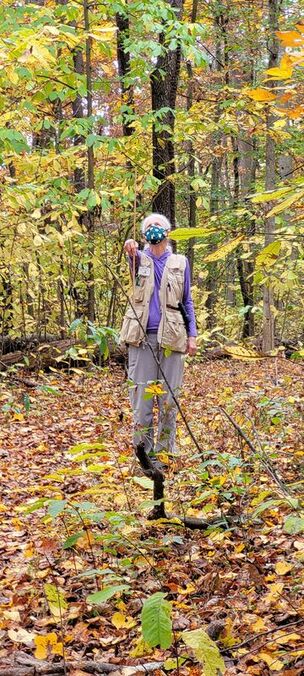 VMN Anne Ellis measuring the height of tulip poplar on the Tree Loop at Banshee Reeks Nature Preserve.
VMN Anne Ellis measuring the height of tulip poplar on the Tree Loop at Banshee Reeks Nature Preserve.
Banshee Reeks Chapter Big Tree Surveys
Contributed by Kyle Baker, Volunteer Service Projects Chair in the VMN-Banshee Reeks Chapter
The Banshee Reeks Chapter has spent some of the down time this summer not only anticipating getting back “out there” and working on volunteer service projects, but also used the time to plan several new flora and fauna surveys for the Chapter. The surveys will provide a better understanding of biodiversity, species occurrences, uncommon species, and non-native species in the natural areas and habitats. The information from these surveys will also inform education and outreach activities in the Chapter and foster an overall appreciation of the natural heritage in area parks and natural areas. Although many of these surveys are planned to begin in 2021, this new survey effort launched this October with two inventory and big tree surveys at the Chapter’s home base of the Banshee Reeks Nature Preserve (BRNP) in Loudoun County. BRNP was first established in 1999 and these are the first systematic tree surveys to occur there.
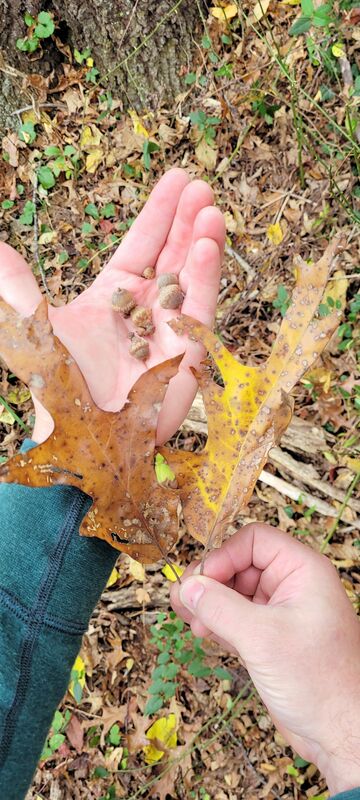 Banshee Reeks VMNs working together to identify an oak tree.
Banshee Reeks VMNs working together to identify an oak tree.
Over two beautiful October days, applying best practices of small team sizes and social distancing, twelve enthusiastic VMNs from the Banshee Reeks Chapter hit the trails and set out on this new survey effort. The surveys have been a great success and are yielding some very interesting initial results. Overall, a small distance of the trails at BRNP have been surveyed so far and 27 species of trees have been identified. Of particular interest is an old fence line we discovered off a trail while investigating a big tree. The survey team followed this fence line and discovered several very large and old trees. Loudoun County maintains its own
Big Tree Registry. Comparing our big tree measurements of the first tree along this fence line indicates is it likely tied in first place with the largest pin oak currently on the Loudoun County Big Tree Registry. Leaf abscission was well underway and the leaves were raining down on us, so since we were losing canopy leaves, our Big Tree Scores are probably on the low end. The Chapter may have, at least, some county champions at BRNP.
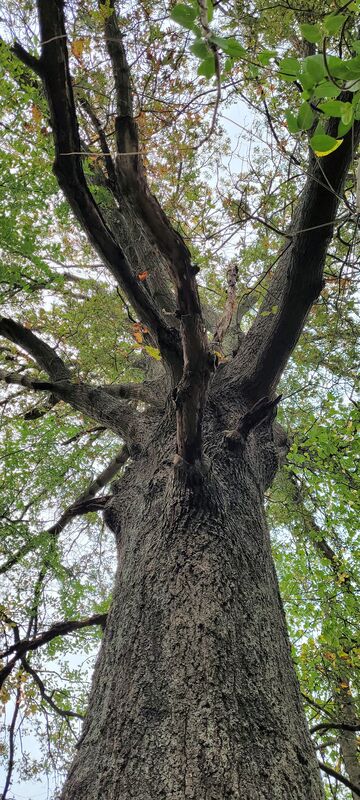 A very big pin oak measured by VMNs at the Banshee Reeks Nature Preserve.
A very big pin oak measured by VMNs at the Banshee Reeks Nature Preserve.
We have just begun to explore this old fence line as it contains a number of big and impressive trees and any big tree contenders for the Big Tree Registry will be submitted for verification in 2021. Working together with outstanding VMNs from the Banshee Reeks Chapter have made these surveys a great success. The flora and fauna surveys will resume in 2021 and we will certainly return to the old fence line to measure these impressive big trees under a full canopy.
Stay tuned to project updates on the project blog on iNaturalist at https://www.inaturalist.org/projects/plants-and-animals-of-banshee-reeks-nature-preserve.
Rivanna Chapter Volunteer Recognized for Service in Fluvanna County
Ida Swenson (VMN-Rivanna Chapter) was featured in the Fluvanna Review. Ida is part of our VMN Golden Circle, and she is a very active volunteer in Fluvanna and neighboring counties, especially with environmental education programming.
Remembering an Exceptional Central Virginia Master Naturalist
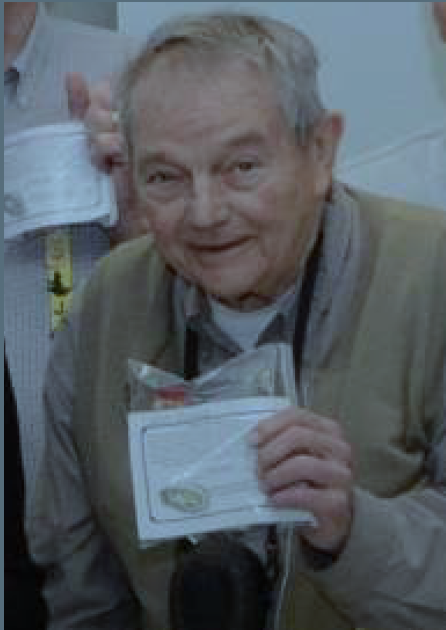 VMN volunteer Bill Bensiek receiving his recertification
VMN volunteer Bill Bensiek receiving his recertification
pin in 2019.
Submitted by Nora Cox and Shelly Evans (VMN-Central Virginia Chapter)
Bill Bensiek, a Virginia Master Naturalist volunteer in the Central Virginia Chapter, passed away in August at the age of 87.
Bill was a constant presence at chapter membership meetings, events, and basic training classes. He drove over 796 miles to volunteer, completed over 237 advanced training hours, and volunteered over 1,057 hours (and there’s no doubt these numbers are underreported)! Bill started with the VMN program in 2006, though he actually was part of the Central Virginia Chapter before that, as it pre-dated the statewide program. Bill was awarded the Acorn Award, an award bestowed to those who start as a trainee and through extraordinary work, usually over a period of time, grows into a Master Naturalist who makes significant contributions to the chapter and/or community, in 2008. He was an inspiration as a Master Naturalist and will be sorely missed.
His obituary in the Lynchburg newspaper states, “Bill loved all things outdoors, including gardening, hiking, and fishing. He was a devoted member of the Central Virginia Master Naturalists for 20 years.”
 The “mystery” female bird turned out to be a Purple Finch. Photo by Kathy Fell.
The “mystery” female bird turned out to be a Purple Finch. Photo by Kathy Fell.  Kathy Fell has been an enthusiastic VMN volunteer for 12 years! Selfie photo by Kathy Fell.
Kathy Fell has been an enthusiastic VMN volunteer for 12 years! Selfie photo by Kathy Fell.


